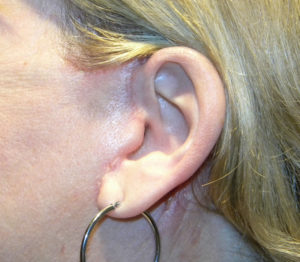The primary motivation for which someone undergoes a facelift is to have a better looking neck and an improved jawline. While discreet scars are an accepted trade-off for this improvement, very visible scars or significant changes in one’s hairline are not.
One of the most common telltale signs of a facelift is the loss of the sideburn hair, known as the temporal tuft. Once the temporal hairline gets pulled up too high, there is no good recovery procedure for its correction. (in men they can just grow longer sideburns to compensate…although not all men can) This may make it no longer aesthetically acceptable for a women to pull her hair up and she may have to wear it down to hide this area.
This cranial and upward migration of this visible hairline area is a direct result of where the facelift incisions were placed in this area. In a traditional facelift, the incision that is used in front of the ear runs up into the temporal hairline. This allows skin to be lifted and repositioned from the jawline and neck as well as across the cheek (midface) area. It also allows for some modest improvement in the nasolabial fold area. However, the benefits of wider facial improvement is done at the price of the temporal tuft moving upward. In women with a low lying temporal hairline, this is not an issue. But in women where the horizontal level of the hairline is already at the top of or close to the attachment of the ear to the face, this will move the hairline up too far.

The placement of incisions around the hairline should be based on the location and height of the sideburn and temporal tuft. In my Indianapolis facelift practice, I have noticed that many women have a high natural hairline location that will be adversely affected after a facelift. In these patients, a blocking hairline approach should be used to avoid improving one cosmetic problem at the expense of creating another.
Dr. Barry Eppley
Indianapolis, Indiana


